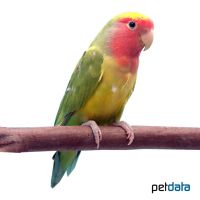Rosy-faced Lovebird Yellow-greenwinged (Agapornis roseicollis 'Yellow-greenwinged')
| Rosy-faced Lovebird Yellow-greenwinged Agapornis roseicollis 'Yellow-greenwinged' | |
|---|---|
| Name | Rosy-faced Lovebird Yellow-greenwinged |
| Name Lat. | Agapornis roseicollis 'Yellow-greenwinged' |
| Family | Parrots |
| Family lat. | Psittacidae |
| Order | Parrots |
| Order lat. | Psittaciformes |
| Origin | Africa |
| Climate | Tropical |
| Diet | Lovebird seed, veggies, fruits |
| Keeping | Pair, group |
| Care Level | Easy |
| Reproduction | Cavity nest |
| Life Span | 10-15 years |
| Protection | No |
| Metric Units | |
| Size | 15 cm |
| Temperature | Room temperature |
| Housing | 100 x 50 x 50 cm |
| US Units | |
| Size | 5.9" |
| Temperature | Room temperature |
| Housing | 40" x 20" x 20" |
Distribution and habitat
The distribution area of the rose-headed lizards reaches from South Africa over Namibia to Southwest Angola. There they live in the dry steppes and grasslands near water. Today they are only offered as a breeding form. The Yellow Rosebud Greenwing is a color morph.
Cage size
The minimum size of the cage is 100 x 50 x 50 cm (L x W x H) for one pair, even in case of justified single keeping. For additional 2 birds, provided species compatibility, the floor space must be increased by 50%. The cage must be placed at a height of at least 80 cm (except for aviaries) in a bright, draught-free and quiet place and should have cross-wiring or netting. Keeping in an aviary with a floor area of at least 1 m² is preferable to keeping in a cage.
Maintenance
The floor must be covered with sand, shavings of untreated wood or similar material and cleaned once a week if possible. At least 2 perches made of wood or branches of different thickness and height shall be installed in such a way as to provide the longest possible flight path and prevent soiling of the feed and water containers. A bathing facility should be available at all times, alternatively they can be sprayed with water at least once a week. In addition to hiding places (burrows or half burrows), they need climbing and occupation material, such as rings, ropes and natural branches that are harmless to health. They should be kept at room temperature.
Diet
The species-specific feed offer consists of mixed seeds, available in specialized trade as "Agapornidenfutter" in premium quality, supplemented with foxtail millet, some green panicle millet, chickweed, organic lettuce, berries, fruits, carrots, in addition fresh twigs with buds and especially for the rearing of young sprouted feed (semi-mature wheat), egg feed and soaked zwieback. If there are several animals, set up several feeding stations. They need grit, cuttlefish and vitamin lime as digestive aids. Drinking water must always be available in birdbaths or in stable, open containers and, like food, must be offered fresh daily in clean containers.
A regular and varied diet prevents deficiency symptoms.
Reproduction and breeding
The sexes are difficult to distinguish by color, the females have a slightly wider leg position.
They breed in nest boxes (also budgerigar nest boxes) in portrait or landscape format and in hollowed tree trunks. Fresh willow twigs (weeping willow) are particularly suitable as nesting material, which is carried in the beak and rump feathers. The clutch consists of 3-6 eggs, the incubation period is about 20 days. The breeding season is, biologically speaking, year-round. Young birds should be raised so that they are species-specific.
The average life expectancy is 10-15 years.
Important
Roseheads should be provided with a leg ring.
The Yellow Rosebud Greenwing is a color morph.
If kept in outdoor aviaries, they also need a heated shelter of at least 0.5 m², which can be visited by the birds at any time. The temperature in the shelter must not fall below 10 °C and the furnishings must be the same as those used for caging
They may only be kept in pairs or in a group. Socialization with other small parrots is well possible. In rooms, including shelters, sufficient daylight or flicker-free artificial light (stroboscopic effect) corresponding to daylight must be provided. The lighting duration shall be 8-12 hours per day and the natural day-night rhythm shall be observed. An adequate room climate is to be provided
If caged, they should be allowed free flight. The health condition of the birds should be checked daily, impurities should be removed regularly.
Further literature can be found in your pet store.
References
Text: petdata; Image: petdata
Source: BMELV (1995): Tierschutzgutachten - Mindestanforderungen an die Haltung von Papageien; ARNDT (1997): Lexikon der Papageien, Arndt Verlag; GRUMMT & STREHLOW (2009): Zootierhaltung - Tiere in menschlicher Obhut: Vögel, Verlag Harri Deutsch
- Gemäß § 21 Abs. 5 Tierschutzgesetz idgF
